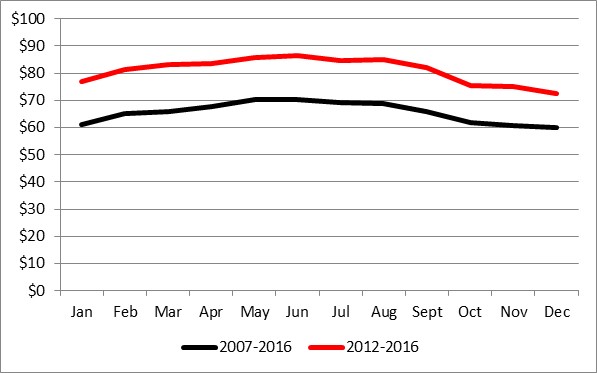– Dr. Kenny Burdine, Livestock Marketing Specialist, University of Kentucky
As is often the case, spring has brought some much needed energy to calf markets. At the time of this writing (April 12, 2017), CME© Feeder Cattle Futures have risen more than $10 per cwt from their early March levels. Rising feeder cattle futures and grass growth have supported calf markets as 550 lb steer calves have moved into the $140’s on a state average basis, with several groups breaking into the $150’s. This represents roughly a $20 per cwt increase from the lows set in fall of 2016.
This is the time of year when calf markets typically reach their seasonal highs as stocker operations place calves into grazing programs. These same calves tend to reach their lows in the fall as more calves move through markets and their value is primarily determined by what feedlots and winter backgrounders can pay for them. Heavier feeder cattle prices show less seasonal tendencies, but are usually highest in the late summer and early fall. I write about seasonality in calf and feeder cattle markets pretty regularly.
For the most part, I have written much less about the seasonal patterns that exist in cull cow markets. However, since cull cow sales are very significant for cow-calf operations, it makes sense to spend a little time discussing these price patterns. Figure one plots both a 5-year and 10-year average for 80-85% boning cull cows. While the most recent 5 years clearly saw higher cull cow prices, both series show the same general seasonal pattern. Cull cow prices tend to be lowest in the late fall and early winter, then increase into spring and summer. This pattern actually follows the seasonal pattern for weaned calves closely.
Figure 1. Cull Cow Prices at KY Auctions
Boning 80-85% ($ per cwt)
Cull cow prices reach their lows in the fall / winter for a couple of reasons. First, since most operations calve in the spring and wean in the fall, more cull cows are marketed during this time as cull cows tend to be sold when calves are weaned. At the same time, feeding costs are higher during the winter months, which makes cull cows less attractive for another producer to purchase to feed or put back into production at this time. Tracking seasonal patterns has been difficult the last several years given the overall volatility in cattle markets. Many factors outside of seasonality have greatly influenced prices and this has led to exaggerated seasonal, and counter-seasonal, price patterns in many cases. So, taking a long-term view on price seasonality is typically best.
Seasonal price indices are often used as a way to quantify seasonal patterns in prices. Figure 2 plots the same data shown in figure 1, but does so using monthly price indices. A monthly price index is best thought of as a percentage of an annual average. For example, the black line in figure 2 plots monthly price indices from 2007 through 2016. Note that that black line reaches a peak in May at about 107. This means that from 2007-2016, boning 80-85% cull cow prices in May were 7% above the annual average. Similarly, that same series reaches its low in December at around 92. This suggests that from 2007-2016, these same prices in December were 8% below that annual average. (Note that the graph may look somewhat exaggerated since the X-axis does not start at zero. This is done to make the two series easier to distinguish since they are so similar.)
Figure 2. Monthly Cull Cow Price Indices at KY Auctions
Boning 80-85%
While cull cow seasonality does not get near as much attention as seasonality in other markets, it is worth consideration. Cow-calf operations make culling decisions on an annual basis and revenue from cull cows does impact their cash flow and the amount of depreciation incurred annually on breeding stock. So, like so many other things, cow-calf operators should be aware of seasonal patterns in cull cow prices.

